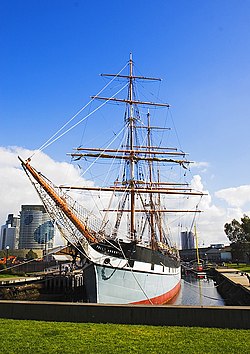Polly Woodside

Polly Woodside is an iron-hulled, three-masted barque currently forming the major attraction of the Melbourne Maritime Museum.
|
|
| History | |
|---|---|
|
|
|
| Owner: |
|
| Builder: | Workman, Clark & Co, Belfast, Northern Ireland. |
| Launched: | December 1885 |
| In service: | 7 December 1885 |
| Renamed: | Rona, 1904 |
| Reclassified: | Coal lighter 1922 |
| Homeport: | Belfast, Northern Ireland (1885–1904), Lyttelton, New Zealand (1904–1912), Auckland, New Zealand (1912–1923), Sydney, Australia (1923–1925), Melbourne, Australia (1925–current) |
| Identification: | KDCN |
| Fate: | Museum ship since 1968 |
| General characteristics | |
| Class and type: | Cargo |
| Type: | Iron hull,Barque rig |
| Tonnage: | 678 gross |
| Length: | Hull:192.2 ft (58.6 m)LOA:230 ft (70 m) |
| Beam: | 30.15 ft (9.19 m) |
| Height: | 108 ft (33 m)(mainmast) |
| Draught: | 14 ft (4.3 m) |
| Propulsion: | Sails |
| Speed: | 14 kt |
| Capacity: | 1,100 tons |
| Complement: | less than 15 |
Polly Woodside is a Belfast-built, three-masted, iron-hulled barque, preserved in Melbourne, Australia, and forming the central feature of the South Wharf precinct. The ship was originally built in Belfast by William J. Woodside and was launched in 1885. Polly Woodside is typical of thousands of smaller iron barques built in the last days of sail, intended for deep water trade around the world and designed to be operated as economically as possible.
Polly Woodside was built at the north shipbuilding yard of Workman, Clark and Co, Queen's Island, Belfast during 1885, for William J. Woodside and Co. She was launched on 7 November 1885; the christening performed by the owner's wife, Mrs Marian ("Polly") Woodside, after whom the ship was named.Polly Woodside captained by Gilbert Yeates, operated as a cargo vessel carrying coal, nitrate, and wheat between British ports and the ports of South America, such as Montevideo, Valparaiso and Buenos Aires. In sixteen voyages between December 1885 and August 1903 she made a number of arduous passages around Cape Horn. The Polly Woodside's operating crew, including master and mate was generally less than 20.
In 1904 Polly Woodside was sold to A.H. Turnbull of New Zealand and renamed Rona after Miss Rona Monro, daughter of a shareholder in the company. Valued in 1906 at £4,300, Rona then generally operated on the New Zealand–Australian run, carrying timber, salt, cement, grain and coal. The ship changed hands in 1911 for £3000 to Captain Harrison Douglas, of New Zealand and again in 1916 to the George H. Scales Company. Because of the heavy loss of shipping in the 1914–1918 war, Rona also traded between New Zealand ports and San Francisco, carrying case oil and copra. Two mishaps occurred in the last years of the ship's sailing career. In March 1920 the schooner W. J. Pirie, under tow in San Francisco harbour, collided with Rona at anchor, carrying away her headgear. Then in June 1921 the Rona, carrying a cargo of coal, grounded on Steeple Rock, off Wellington Heads. Fortunately, the shingle bottom caused little damage and she was able to be towed into Wellington harbour. However, some slight stress fractures to the hull plating could still be seen when the ship was dry-docked in 1974.
...
Wikipedia
